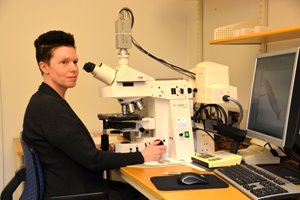A challenging job turning out better than expected
A challenging job turning out better than expected
Jessica Sjöstedt, working with the light microscope at MoRe since one year says. ”I looked forward to starting to work at MoRe but did not quite know what to expect. But as it turned out, this is a job with many challenges making my work very interesting, far better than I could hope for.”
In 2002 Jessica graduated with Master of Science in molecular biology at Umeå University followed by doctoral studies on the effects of sex hormones on the brain. After her dissertation in 2007 she worked with development of pharmaceuticals in Umeå. Since 2005 Jessica has used a light microscope as a tool when doing cellular studies and has thus gained a lot of experience.
“Every day is different as our orders vary so much. Our cooperation within the troubleshooting group is key as we want to give the customers valuable input to solving problems, irrespective of the sample. We mainly deal with samples of pulp, paper or board, or possibly problems at our customers’ customers. But we also do other sorts of testing, such as water or metal samples and everything in between, and also house dust. We see no limitations for our work, only the possibilities.”
“Quite often customers send us pulp, paper or board samples from different, anonymous, competitors. What they want to know is types of fibre or pulp and fibre composition. If the board or paper is coated they also want to know the type of filler and binder, the composition of the coating, the number of coating layers and so on. Light microscopy combined with SEM and FTIR will reveal almost everything about the samples.”
“You have to work like a detective in this job, using all your skills and experience as well as the equipment. The problems can be so different, from the customer’s own process with impurities in pulp, paper or board samples, depositions, sludge, bacteria and fungal hyphae, i.e. mould. We also receive customer complaints on paper and board where we have to be able to ascertain whether the end customer has caused the problem or if the paper or board supplier has done so. When the problem originates from the mill our explanation may contribute to actions which prevent that the problem goes on and causes more claims. If necessary process consultants from MoRe can help out on site in the mill.”
“When I shall examine a cross section of e.g. a board sheet I embed it in plastic and make an extremely thin cross section for a study with transmitted light. Our light microscope is very advanced with different light techniques such as raking light, fluorescent light, polarised light, phase contrast and DIC – differential interference contrast, giving a three dimensional image. Depending on type of problem and type of sample we use these different light techniques in order to find the cause of the problem.”
“My introduction at MoRe was excellent, very much due to that I got to work together with Birgitta Lundgren until she retired. I’ve felt welcome from day 1. MoRe is a very good company to work for, not only due to the tasks but also the excellent working climate.”
When not studying particles of the world through the light microscope, what do you do then?
“We have two afghan dogs which we earlier used to exhibit. Now they are older and I have cut their furs as we do a lot of walking in the woods and I want to avoid them getting stuck in twigs and other things. In the summer my husband and I love to drive our motorbikes off-road on dirt roads. I’ve always liked driving motorbikes and when I met my husband six years ago I finally got my driver’s licence. I have a Honda 650 cc which I mostly drive on small roads as you get to see much more of the surroundings that way,” says Jessica Sjöstedt.
Contact: Jessica Sjöstedt, +46 70 243 99 98, E-mail
